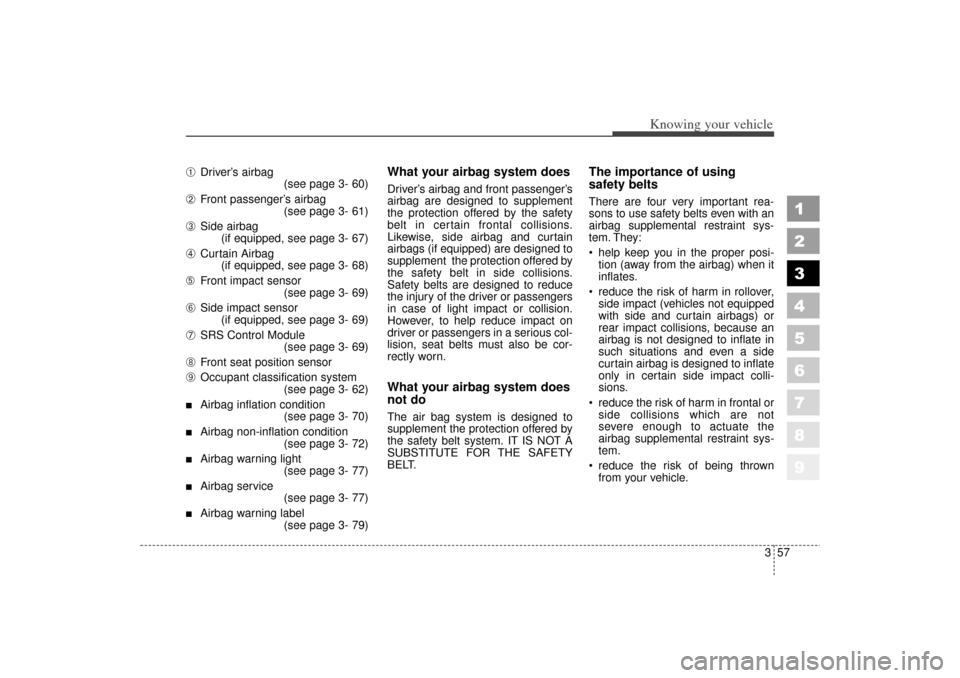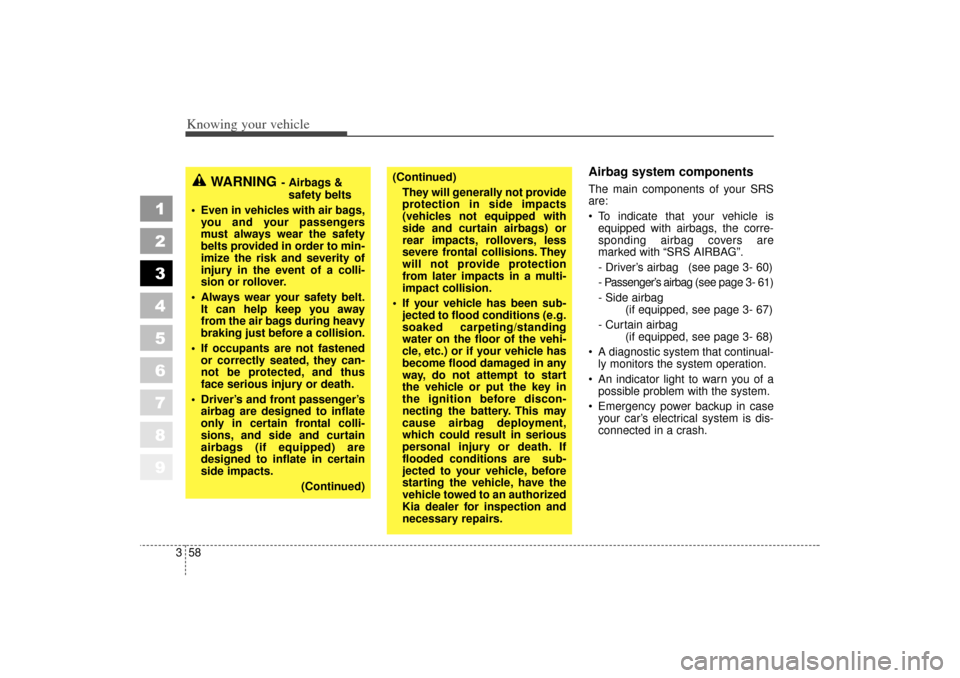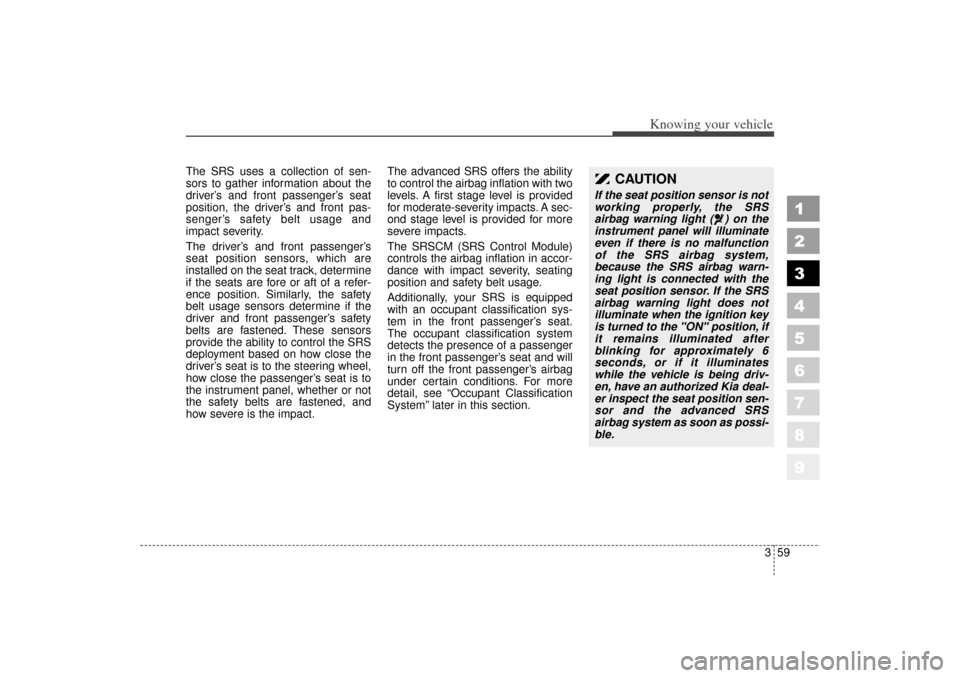KIA Spectra 2006 2.G Repair Manual
Manufacturer: KIA, Model Year: 2006, Model line: Spectra, Model: KIA Spectra 2006 2.GPages: 273, PDF Size: 2.83 MB
Page 61 of 273

Knowing your vehicle50
3
1
2
3
4
5
6
7
8
9
3. Pull the shoulder portion of the
safety belt all the way out. When
the shoulder portion of the safety
belt is fully extended, it will shift
the retractor to the “Auto Lock”
(child restraint) mode. 4. Slowly allow the shoulder portion
of the safety belt to retract and lis-
ten for an audible “clicking” or
“ratcheting” sound. This indicates
that the retractor is in the “Auto
Lock” mode. If no distinct sound is
heard, repeat steps 3 and 4. 5. Remove as much slack from the
belt as possible by pushing down
on the child restraint system while
feeding the shoulder belt back into
the retractor.
6. Push and pull on the child restraint system to confirm that the safety
belt is holding it firmly in place. If it
is not, release the safety belt and
repeat steps 2 through 6.
"Click"
MMSA3029
MMSA3030
MMSA3028
LD CAN (ENG) new 3-1~.qxd 7/29/05 10:28 AM Page 50
Page 62 of 273

351
1
2
3
4
5
6
7
8
9
Knowing your vehicle
7. Double check that the retractor isin the “Auto Lock” mode by
attempting to pull more of the safe-
ty belt out of the retractor. If you
cannot, the retractor is in the “Auto
Lock” mode.
To remove the child restraint, press
the release button on the buckle and
then pull the lap/shoulder belt out of
the restraint and allow the safety belt
to retract fully.
✽ ✽ NOTICEWhen the safety belt is allowed to
retract to its fully stowed position,
the retractor will automatically
switch from the “Auto Lock” mode
to the emergency lock mode for nor-
mal adult usage.
WARNING
- Auto lock
mode
The lap/shoulder belt automati-
cally returns to the “emergency
lock mode” whenever the belt is
allowed to retract fully.
Therefore, the preceding seven
steps must be followed each
time a child restraint is
installed.
If the safety belt is not placed in
the “auto lock” mode, severe
injury or death could occur to
the child and/or other occupants
in the vehicle in a collision,
since the child restraint will not
be effectively held in place.
LD CAN (ENG) new 3-1~.qxd 7/29/05 10:28 AM Page 51
Page 63 of 273

Knowing your vehicle52
3
1
2
3
4
5
6
7
8
9
WARNING
- Child
restraint
Check that the child restraint
system is secure by pushing
and pulling it in different direc-
tions. Incorrectly fitted child
restraints may swing, twist, tip
or come away causing death or
injury.
Securing a child restraint seat
with “Tether Anchor” system
Child restraint hook holders are
located on the shelf or floor behind
the rear seats.
1. Open the tether anchor cover on the shelf or floor behind the rear
seats. 2. Route the child restraint seat strap
over the seatback.
For vehicles with adjustable head-
rest, route the tether strap under
the headrest and between the
headrest posts, otherwise route
the tether strap over the top of the
seatback.
3. Connect the tether strap hook to the correct child restraint hook
holder and tighten to secure the
seat.
2GHN3300A
WARNING
If the tether strap is secured
incorrectly, the child restraint
seat may not be restrained
properly in the event of a colli-
sion.
1LDN3200/1LDN3200A
4 Door5 Door
LD CAN (ENG) new 3-1~.qxd 7/29/05 10:28 AM Page 52
Page 64 of 273

353
1
2
3
4
5
6
7
8
9
Knowing your vehicle
Child seat lower anchors
Some child seat manufacturers
make child restraint seats that are
labeled as International Standards
Organization Fixed (ISOFIX) or
ISOFIX-compatible child restraint
seats. These seats include two rigid
or webbing mounted attachments
that connect to two ISOFIX anchors
at specific seating positions in your
vehicle. This type of child restraint
seat eliminates the need to use seat
belts to attach the child seat for for-
ward-facing child restraint seats in
the rear seats.There is a symbol located on the
lower portion of each side of the rear
seatbacks. These symbols indicate
the position of the lower anchors for
child restraints so equipped.
1LDN3050
WARNING - Child restraint anchorage
Child restraint anchorages are designed to withstand only
those loads imposed by cor-
rectly fitted child restraints.
Under no circumstances are
they to be used for adult seat
belts or harnesses or for
attaching other items or
equipment to the vehicle.
The tether strap may not work properly if attached some-
where other than the correct
tether anchor.
1LDN3100/1LDN3100AChild lower anchor
Label
LD CAN (ENG) new 3-1~.qxd 7/29/05 10:28 AM Page 53
Page 65 of 273

Knowing your vehicle54
3
1
2
3
4
5
6
7
8
9
ISOFIX anchors have been provided
in your vehicle. The ISOFIX anchors
are located in the left and right out-
board rear seating positions. Their
locations are shown in the illustra-
tion. There is no ISOFIX anchor pro-
vided for the center rear seating
position.
The ISOFIX anchors are located
between the seatback and the seat
cushion of the rear seat left and right
outboard seating positions. Follow the child seat manufacturer
’s
instructions to properly install child
restraint seats with ISOFIX or
ISOFIX-compatible attachments.
Once you have installed the ISOFIX
child restraint, assure that the seat is
properly attached to the ISOFIX and
tether anchors. Also, test the child
restraint seat before you place the
child in it. Tilt the seat from side to
side. Also try to tug the seat forward.
Check to see if the anchors hold the
seat in place.
WARNING
If the child restraint is not
anchored properly, the risk of a
child being seriously injured or
killed in a collision greatly
increases.
1LDN3100/SBGQ03102
WARNING
When using the vehicle's
"ISOFIX" system to install a
child restraint system in the rear
seat, all unused vehicle rear
seat belt metal latch plates or
tabs must be latched securely in
their seat belt buckles and the
seat belt webbing must be
retracted behind the child
restraint to prevent the child
from reaching and taking hold
of unretracted seat belts.
Unlatched metal latch plates or
tabs may allow the child to
reach the unretracted seat belts
which may result in strangula-
tion and a serious injury or
death to the child in the child
restraint.
LD CAN (ENG) new 3-1~.qxd 7/29/05 10:28 AM Page 54
Page 66 of 273

355
1
2
3
4
5
6
7
8
9
Knowing your vehicle
(Continued)In a crash, the child restraint
seat ISOFIX attachments may
not be strong enough to
secure the child restraint seat
improperly in the rear center
seating position and may
break, causing serious injury
or death.
Attach the ISOFIX or ISOFIX- compatible child restraint seat
only to the appropriate loca-
tions shown in the illustration.
Always follow the installation and use instructions provided
by the manufacturer of the
child restraint.
WARNING
Do not mount more than onechild restraint to a single teth-
er or to a child restraint lower
anchorage point. The improp-
er increased load may cause
the anchorage points or tether
anchor to break, causing seri-
ous injury or death.
Do not install a child restraint seat at the rear center seating
position using the vehicle’s
ISOFIX anchors. The ISOFIX
anchors are only provided for
the left and right outboard rear
seating positions. Do not mis-
use the ISOFIX anchors by
attempting to attach a child
restraint seat in the middle
rear seating position to the
ISOFIX anchors.
(Continued)
LD CAN (ENG) new 3-1~.qxd 7/29/05 10:28 AM Page 55
Page 67 of 273

Knowing your vehicle56
3
1
2
3
4
5
6
7
8
9
AIRBAG - SUPPLEMENTAL RESTRAINT SYSTEM ➀Driver’ s airbag
➁Front passenger’ s
airbag
➃Curtain Airbag (if equipped)
➄Front impact sensor
➆SRS control
module
➈ Occupant classifi-
cation system
1LDC2047/1LDN2048/1LDA2049/1LDN2050/1LDN2051/1LDA2052/1LDN2053/1LDN2055A/1LDA2054/1LDN2055A/1LDN2166/1LDN2167/1LDN2168
➂Side airbag (if equipped)
\bSide impact sensor
(if equipped)
➇ Front seat position
sensor
LD CAN (ENG) new 3-1~.qxd 7/29/05 10:28 AM Page 56
Page 68 of 273

357
1
2
3
4
5
6
7
8
9
Knowing your vehicle
➀
Driver’s airbag
(see page 3- 60)
➁
Front passenger’ s airbag
(see page 3- 61)
➂
Side airbag (if equipped, see page 3- 67)
➃
Curtain Airbag(if equipped, see page 3- 68)
➄ Front impact sensor
(see page 3- 69)
\b
Side impact sensor(if equipped, see page 3- 69)
➆
SRS Control Module (see page 3- 69)
➇
Front seat position sensor
➈
Occupant classification system(see page 3- 62)
Airbag inflation condition(see page 3- 70)
Airbag non-inflation condition(see page 3- 72)
Airbag warning light(see page 3- 77)
Airbag service(see page 3- 77)
Airbag warning label(see page 3- 79)
What your airbag system doesDriver’s airbag and front passenger’ s
airbag are designed to supplement
the protection offered by the safety
belt in certain frontal collisions.
Likewise, side airbag and curtain
airbags (if equipped) are designed to
supplement the protection offered by
the safety belt in side collisions.
Safety belts are designed to reduce
the injury of the driver or passengers
in case of light impact or collision.
However, to help reduce impact on
driver or passengers in a serious col-
lision, seat belts must also be cor-
rectly worn.What your airbag system does
not doThe air bag system is designed to
supplement the protection offered by
the safety belt system. IT IS NOT A
SUBSTITUTE FOR THE SAFETY
BELT.
The importance of using
safety beltsThere are four very important rea-
sons to use safety belts even with an
airbag supplemental restraint sys-
tem. They:
help keep you in the proper posi-
tion (away from the airbag) when it
inflates.
reduce the risk of harm in rollover,
side impact (vehicles not equipped
with side and curtain airbags) or
rear impact collisions, because an
airbag is not designed to inflate in
such situations and even a side
curtain airbag is designed to inflate
only in certain side impact colli-
sions.
reduce the risk of harm in frontal or
side collisions which are not
severe enough to actuate the
airbag supplemental restraint sys-
tem.
reduce the risk of being thrown
from your vehicle.
LD CAN (ENG) new 3-1~.qxd 7/29/05 10:28 AM Page 57
Page 69 of 273

Knowing your vehicle58
3
1
2
3
4
5
6
7
8
9
Airbag system components The main components of your SRS
are:
To indicate that your vehicle is
equipped with airbags, the corre-
sponding airbag covers are
marked with “SRS AIRBAG”.
- Driver’ s airbag (see page 3- 60)
- Passenger’ s airbag(see page 3- 61)
- Side airbag (if equipped, see page 3- 67)
- Curtain airbag (if equipped, see page 3- 68)
A diagnostic system that continual-
ly monitors the system operation.
An indicator light to warn you of a
possible problem with the system.
Emergency power backup in case
your car’ s electrical system is dis-
connected in a crash.
WARNING
- Airbags &
safety belts
Even in vehicles with air bags, you and your passengers
must always wear the safety
belts provided in order to min-
imize the risk and severity of
injury in the event of a colli-
sion or rollover.
Always wear your safety belt. It can help keep you away
from the air bags during heavy
braking just before a collision.
If occupants are not fastened or correctly seated, they can-
not be protected, and thus
face serious injury or death.
Driver’s and front passenger’s airbag are designed to inflate
only in certain frontal colli-
sions, and side and curtain
airbags (if equipped) are
designed to inflate in certain
side impacts.
(Continued)
(Continued)They will generally not provide
protection in side impacts
(vehicles not equipped with
side and curtain airbags) or
rear impacts, rollovers, less
severe frontal collisions. They
will not provide protection
from later impacts in a multi-
impact collision.
If your vehicle has been sub- jected to flood conditions (e.g.
soaked carpeting/standing
water on the floor of the vehi-
cle, etc.) or if your vehicle has
become flood damaged in any
way, do not attempt to start
the vehicle or put the key in
the ignition before discon-
necting the battery. This may
cause airbag deployment,
which could result in serious
personal injury or death. If
flooded conditions are sub-
jected to your vehicle, before
starting the vehicle, have the
vehicle towed to an authorized
Kia dealer for inspection and
necessary repairs.
LD CAN (ENG) new 3-1~.qxd 7/29/05 10:28 AM Page 58
Page 70 of 273

359
1
2
3
4
5
6
7
8
9
Knowing your vehicle
The SRS uses a collection of sen-
sors to gather information about the
driver’s and front passenger’ s seat
position, the driver’ s and front pas-
senger’ s safety belt usage and
impact severity.
The driver’ s and front passenger’ s
seat position sensors, which are
installed on the seat track, determine
if the seats are fore or aft of a refer-
ence position. Similarly, the safety
belt usage sensors determine if the
driver and front passenger’ s safety
belts are fastened. These sensors
provide the ability to control the SRS
deployment based on how close the
driver’ s seat is to the steering wheel,
how close the passenger’ s seat is to
the instrument panel, whether or not
the safety belts are fastened, and
how severe is the impact. The advanced SRS offers the ability
to control the airbag inflation with two
levels. A first stage level is provided
for moderate-severity impacts. A sec-
ond stage level is provided for more
severe impacts.
The SRSCM (SRS Control Module)
controls the airbag inflation in accor-
dance with impact severity, seating
position and safety belt usage.
Additionally, your SRS is equipped
with an occupant classification sys-
tem in the front passenger’
s seat.
The occupant classification system
detects the presence of a passenger
in the front passenger’ s seat and will
turn off the front passenger ’s airbag
under certain conditions. For more
detail, see “Occupant Classification
System” later in this section.
CAUTION
If the seat position sensor is not
working properly, the SRS
airbag warning light ( ) on the
instrument panel will illuminate
even if there is no malfunction
of the SRS airbag system,
because the SRS airbag warn-
ing light is connected with the
seat position sensor. If the SRS
airbag warning light does not
illuminate when the ignition key
is turned to the "ON" position, if
it remains illuminated after
blinking for approximately 6
seconds, or if it illuminates
while the vehicle is being driv-
en, have an authorized Kia deal-
er inspect the seat position sen-
sor and the advanced SRS
airbag system as soon as possi-
ble.
LD CAN (ENG) new 3-1~.qxd 7/29/05 10:28 AM Page 59